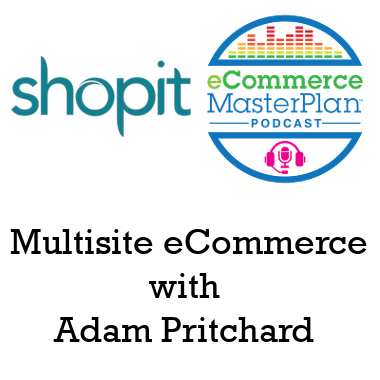Multisite eCommerce – why should you have more than one website? With Shopit’s Adam Pritchard (episode 217)
Adam Pritchard is the founder of Shopit – the UK’s only Pay as you grow eCommerce platform.
I’ve known Adam for a few years and when we caught up for coffee at IRX (internet retailing expo) this year ended up talking about all the many many reasons you could benefit from having multiple websites.
It was such an interesting discussion I thought we should recreate it for all of you – so that’s what Adam’s joining me to discuss in today’s episode.
Without the sponsors the podcast wouldn’t be possible – please do check them out:
This episode is brought to you by SendPro Online from Pitney Bowes.
SendPro Online makes it easy to save time and money–no matter what you send or ship–and you’ll always get the best rates and never overpay!
With SendPro, you can compare shipping rates between carriers, plus save 5 cents a letter and up to 40 percent off USPS Priority Mail shipping.
As a listener you can get a FREE 30-day trial and a FREE 10 pound scale, but only when you visit pb.com/masterplan

This episode is brought to you by the world’s first Pay as you Grow ecommerce platform – Shopit. Supporting online sellers of every size, Shopit gives EVERY customer EVERY feature they need to run an eCommerce business from day one – irrespective of their turnover. You can grow your empire with multiple web sites, full inventory management and more – all from one central login. What’s more, you ONLY pay for usage, so you can focus your budgets on your growth marketing. Plus there’s a lifetime low 1.6% payment gateway rate for everyone – Shopit really do support growing businesses.Sign up for your free trial now at shopitcommerce.com/masterplan
Subscribe on your Favourite Podcast App

How Adam Got Started
Adam started his career in eCommerce in the early 2000’s. During that time he worked for a few big companies and says that as the youngest person in the room, he became the go-to guy for anything having to do with computers. As it often does, those trial by fire experiences led him to several web development projects.
With more experience under his belt, Adam was eventually tasked with running the division for small businesses where he cut his teeth on multi-site strategy and became a leading expert in that niche. Even though Adam was brought up in larger companies, he’s always been a champion for smaller businesses and has geared his own business, Shopit, toward small and growing retailers.
Adam says that he tries to optimize systems and processes so that they are accessible to small businesses.
Listen to learn how multi-site strategies aren’t just for the big guys.
Why Retailers Should Go Multi-Site
There are multiple reasons why multi-site makes so much sense for businesses both large and small. For most people, the first dynamic that would necessitate a multi site strategy would be the desire to go international and begin entering other language markets.
Another big push might be companies looking to enter the wholesale market. For Adam, though, the most exciting way to use multiple sites is for niche marketing. By creating multiple sites, companies can build a powerful customer experience for specific demographics.
Essentially, multi site allows businesses to sell the same product across multiple websites targeted at different demographics.
Listen to learn what the benefits of going to a multi-site model are.
Building a Strong Foundation
The most crucial component of running a successful eCommerce business is arguably managing the back end properly. The order tracking, sku assembly and warehouse facilities all need to be in place for any eCommerce business to operate smoothly.
However, a lot of companies build the front end up first and then scramble to assemble the back side as they go. If done properly, a multi-site strategy shouldn’t mean loads of additional work if everything on the back end is keyed in properly. Adam emphasizes that the database and back end are the essential structures.
How to get people to your website(s)
For the multi-site strategy to work most effectively, most businesses will need to have a ‘supermarket’ version of their website. From that point, the business can build demographic specific sites as well. For example, if a shoe company wants to sell the same pair of sneakers to skateboarders and to parents of young children—different marketing and communication structures will attract those demographic subsets more effectively.
While marketing can become extremely nuanced—there are loads of tactics ranging from email marketing to paid ads and social media—starting with two or more different sites can make the process of communicating to different groups simpler. And the design of the niche sites doesn’t necessarily need to differ that much from the home site because, as Adam points out, your niche market will likely never end up on your main ‘supermarket’ site.
In terms of duplicating social media accounts and so on, Adam says it’s important for certain demographics, but not necessary in every case.
Testing
The other huge benefit to a multi-site approach is how easy it makes testing. Adam says that those niche markets provide the perfect opportunity to test everything from marketing campaigns to product pricing.
eCommerce Book Top Tip
- The Long Tail by Chris Anderson
- Shoe Dog by Phil Knight
eCommerce Traffic Top Tip
- SEO – A slow burn, but worth it.
- Social Advertising – phenomenally low pricing and very well targeted ads have great data returns. Be daring in your social media advertising.
Tool Top Tip
- Talking – Nothing replaces talking one to one communication.
Growth Top Tip
- Multi Site/ Multi Channel Approach




